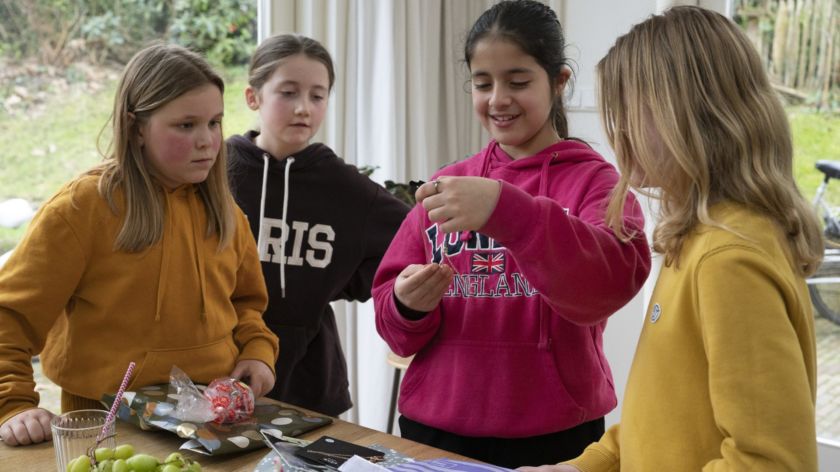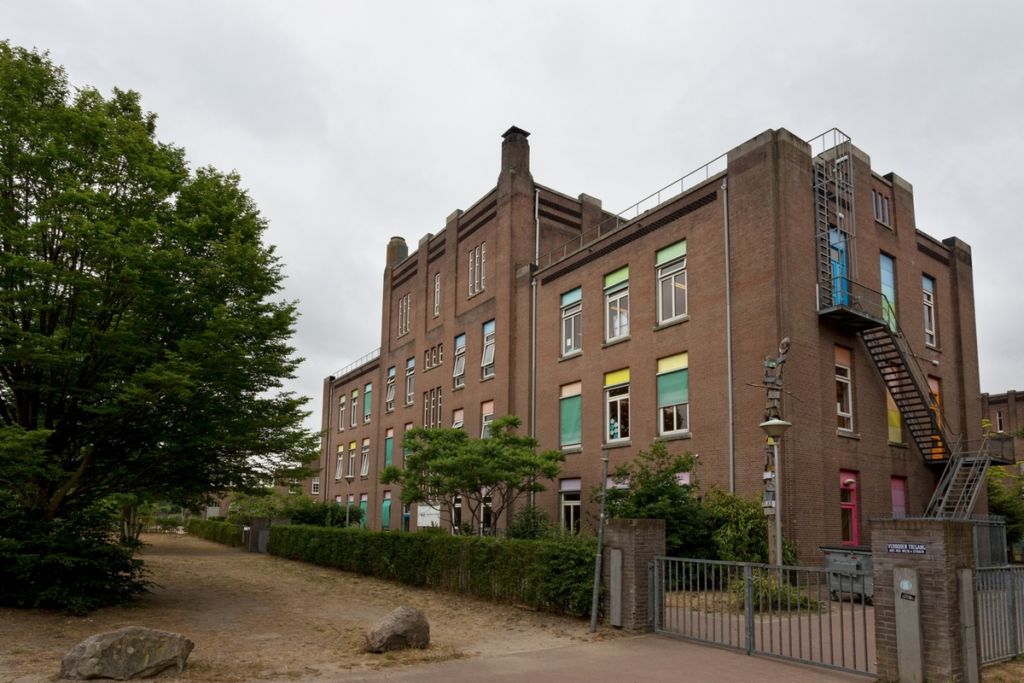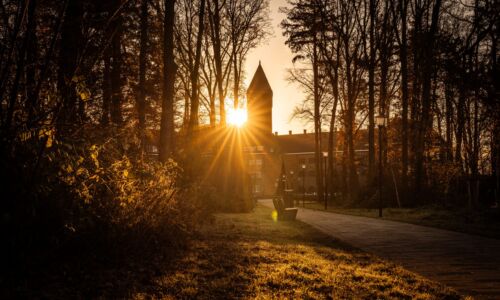Scientists protest against ‘towing’ asylum children: ‘Let them stay in The Netherlands’
-
 Ghena (pink sweater) while saying goodbye with her friends. Photo: Paul Rapp
Ghena (pink sweater) while saying goodbye with her friends. Photo: Paul Rapp
The sudden departure of two families from the asylum seekers’ centre (azc) in Nijmegen has created a lot of unrest at primary school De Muze. Three parents, working at Radboud University, are now taking action to allow the children to stay in The Netherlands. Dragging children from azc to azc has to stop as well, they think.
Children, parents, and teachers at primary school De Muze in Nijmegen-East are in an uproar. In the span of one week, two families, with four children at the school, have left the neighbouring azc.
Last Wednesday Miral (16), Ghena (12), Jouri (6), Basel (4) and their parents moved from the asylum seekers’ centre in Nijmegen-East to Katwijk aan Zee. About a week earlier Paristo (14) and Iliad (6) were also transferred to the same location, which is meant for families that no longer have a chance at asylum.
Campaign
In De Gelderlander Ghena reacted resignedly to the whole situation. The azc in Nijmegen was already her fifth one in four years time. ‘Assen, Arnhem, Wageningen, Grave. I no longer remember what order they were in. And now in Nijmegen. I thought this would be our last azc.’
‘He had friends, everything went great. Now he is suddenly gone’
Parents, children but also the school board of De Muze started – together with the Montessori College – a campaign and a petition to bring attention to the fate of children such as Ghena who, sometimes unannounced, are snatched from their familiar environment, where they go to school and have friends.
Karen Geertsema, Joris Schapendonk and Inge Volman are three of those parents. They also work at the university. Geertsema is lecturer in migration law, Schapendonk is a social geographer and Volman, as cognitive neurologist, keeps busy with valorisation on campus.
Volman: ‘My youngest was in the same class as Jouri. Both of my children were in the same class as Iliad, who left suddenly last week without being able to say goodbye. I saw him for years and after a rough start he was doing well. He had friends, everything was great. Now he is suddenly gone.’
Geertsema: ‘My two eldest have already left De Muze. My youngest is still in school, but not in the same class as the transferred children. I did however, as an involved parent, give a fun jigsaw workshop which Ghena attended. I got involved with the campaign around these children because I worked as an asylum lawyer for years. A parent asked me to help.’
How have your children experienced these past two weeks?
Schapendonk: ‘The stories my son brings home show the injustice he feels. It keeps him busy a lot. “Dad, you have to put your signature in the right place, otherwise it’ll go wrong.”’
Volman: ‘Luckily my toddler was able to say goodbye to Jouri. The class made drawings and presents were bought. That is very important.’
‘Such a family location is very meagre, aimed at deportation
Geertsema: ‘Ghena was in seventh grade. There, classmates take action themselves. That works as an encouragement for parents to do something as well. I found it quite powerful the principal spoke out in the media. Those transfers are horrible for the children, but unworkable for a school as well. As a teacher, you need to cope with this in a class.’
How are the transferred children?
Volman: ‘We occasionally have contact with the families. Most of what we hear about how they are doing is through other people.’
Geertsema: ‘But as a migration lawyer I know a family location like the one in Katwijk has restricted freedom. It’s very meagre, aimed at deportation. There are organisations who have been advocating for these locations to become more kid-friendly for years.’
Schapendonk: ‘As a migration scientist I often write about the injustice happening at the outer borders of Europe. But there is also injustice here. It is important to do something about that. As scientists, we are always looking for a way to impact society. Well, now we can.’
Geertsema: ‘At the same time it is a dilemma. That these children have to leave, is the result of the way we have rigged the procedure. It’s inevitable that some requests are declined. But that doesn’t take away that there is a lot to be remarked about the way asylum seekers are suddenly transferred. The COA (Central Agency for the Reception of Asylum Seekers, ed.) has been saying for years that they won’t transfer children in the middle of a school year. Children should also not be transferred more than five or six times. That still happens and it is important to make this visible.’
Schapendonk: ‘Towing asylum seekers during the procedure is not good for the wellbeing of children at all. Moving people around multiple times looks like a thought-out strategy by the government. That way, asylum seekers don’t get the chance to feel at home at the place they are staying. The crux is that it happens nevertheless: you can keep snatching asylum seekers out of their environment, but they’ll still connect, for example because the children have a right to education.’
Are you only against transferring asylum children in general or do you want the children that were moved to Katwijk to receive a residence permit? What is your action aimed at?
Volman: ‘Our first goal is that these children, who are rooted here, are allowed to stay in The Netherlands. That is what we aim for. Secondly we want there to be more attention to children who experience something similar in their procedure.’
Schapendonk: ‘This is, among other people, about a six-year-old child, who has been living here for five years. His life is here. I can’t stomach that these children will have to live at the family location in Katwijk for years. And it’s still a question whether they’ll actually be deported. They come from an area where the authorities don’t always cooperate with forced departure.’
‘A large portion of their childhood is taken from them’
Geertsema: ‘You pretty much already know they’ll be living there for years. Maybe even eight years. That deserves to be in the spotlight. A large portion of their childhood is taken from them, completely out of these children their control. Shouldn’t we then say: these people are allowed to stay? At the same time, I’m also realistic: I understand not everyone can receive a permit.’
Sometimes it’s like only asylum seekers who have been in the news extensively receive a residence permit. We’ve had Lily and Howick, Nemr, Mauro.
Geertsema: ‘There are enough examples where that hasn’t worked. With our action, we primarily want to show some dignity to the families. Let them know they are not forgotten. With the main driving force for us parents: we can’t explain this to our child, so we should do something about it.’
Schapendonk: ‘That is an important driving force for this action indeed. Doing nothing was not an option for me. Because of my contacts, I might be able to help the families that were transferred to Katwijk here and there, make their lives a little bit easier. Even if it’s just to give them the idea they’re not forgotten.’
You’re personally involved in this case. Is that different than your work as scientists?
Geertsema: ‘I used to be an asylum lawyer – in that role you support asylum seekers. The last twelve years I’ve worked as a scientist and learned to look at the bigger picture, to shine a light on all aspects of this social issue. That creates more distance. As a scientist, I don’t want to just oppose everything, but also think constructively: how should it be done?’
Schapendonk: ‘My approach as researcher is to work very closely to the living environment of the migrant. In this case I’m even more emotionally involved because it’s about the school of my child. Zooming out and looking at the bigger picture is harder in this case.’




